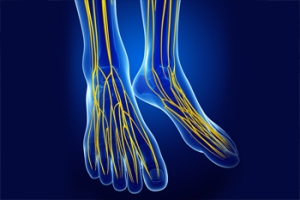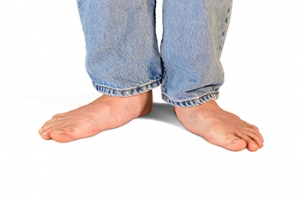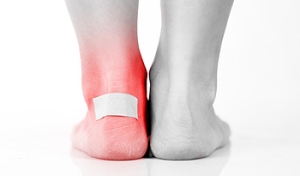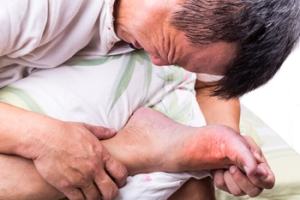

Signs of Athlete’s Foot
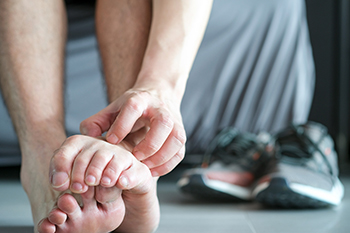 Athlete’s foot is a fungal infection on the feet that causes a red, scaly and itchy rash between the toes. The skin may form blisters, as well as crack and peel. The fungus that causes Athlete’s foot is very contagious and thrives in warm and moist environments like showers, locker rooms and pools. It often spreads from the floors, towels, or clothing. Athlete’s foot can spread around the feet as well. If it isn’t treated properly, Athlete’s foot can spread to the toenails, causing them to be thick and discolored, and it can spread to the hands if touched. Patients who believe that they have Athlete’s foot should make sure to keep their feet dry and not share any common items like shoes, socks and towels because of how contagious it is. Patients who believe that they have Athlete’s foot should consult with a podiatrist for a proper diagnosis and treatment path.
Athlete’s foot is a fungal infection on the feet that causes a red, scaly and itchy rash between the toes. The skin may form blisters, as well as crack and peel. The fungus that causes Athlete’s foot is very contagious and thrives in warm and moist environments like showers, locker rooms and pools. It often spreads from the floors, towels, or clothing. Athlete’s foot can spread around the feet as well. If it isn’t treated properly, Athlete’s foot can spread to the toenails, causing them to be thick and discolored, and it can spread to the hands if touched. Patients who believe that they have Athlete’s foot should make sure to keep their feet dry and not share any common items like shoes, socks and towels because of how contagious it is. Patients who believe that they have Athlete’s foot should consult with a podiatrist for a proper diagnosis and treatment path.
Athlete’s Foot
Athlete’s foot is often an uncomfortable condition to experience. Thankfully, podiatrists specialize in treating athlete’s foot and offer the best treatment options. If you have any questions about athlete’s foot, consult with Dr. Randy Garr from Bigfoot Podiatry. Our doctor will assess your condition and provide you with quality treatment.
What Is Athlete’s Foot?
Tinea pedis, more commonly known as athlete’s foot, is a non-serious and common fungal infection of the foot. Athlete’s foot is contagious and can be contracted by touching someone who has it or infected surfaces. The most common places contaminated by it are public showers, locker rooms, and swimming pools. Once contracted, it grows on feet that are left inside moist, dark, and warm shoes and socks.
Prevention
The most effective ways to prevent athlete’s foot include:
- Thoroughly washing and drying feet
- Avoid going barefoot in locker rooms and public showers
- Using shower shoes in public showers
- Wearing socks that allow the feet to breathe
- Changing socks and shoes frequently if you sweat a lot
Symptoms
Athlete’s foot initially occurs as a rash between the toes. However, if left undiagnosed, it can spread to the sides and bottom of the feet, toenails, and if touched by hand, the hands themselves. Symptoms include:
- Redness
- Burning
- Itching
- Scaly and peeling skin
Diagnosis and Treatment
Diagnosis is quick and easy. Skin samples will be taken and either viewed under a microscope or sent to a lab for testing. Sometimes, a podiatrist can diagnose it based on simply looking at it. Once confirmed, treatment options include oral and topical antifungal medications.
If you have any questions, please feel free to contact our office located in Provo, UT . We offer the newest diagnostic and treatment technologies for all your foot care needs.
How to Deal with Athlete's Foot
Athlete’s foot is a type of fungal infection that affects the skin on the feet. It is caused when the tinea fungus grows on the foot. It is possible to catch the fungus through direct contact with someone who has it or by touching a surface that is contaminated with it. This type of fungus thrives in warm, moist environments such as showers, locker room floors, and swimming pools. Your risk of getting it may also increase by wearing tight-fitting, closed-toe shoes, or by having sweaty feet.
Symptoms of athlete’s foot include itching, stinging or burning sensations between the toes. You may also experience toenails that are discolored, thick, crumbly, or toenails that pull away from the nail bed.
Your podiatrist may diagnose athlete’s foot by detecting these symptoms or by doing a skin test to see if there is a fungal infection present. The most common exam used to detect Athlete’s foot is a skin lesion potassium hydroxide exam. To use this method, your doctor will scrape off a small area of the infected skin and place it into potassium hydroxide. The potassium hydroxide will destroy the normal cells and leave the fungal cells untouched so that they are visible under a microscope.
There are a variety of treatment options for athlete’s foot. Some medications are miconazole (Desenex), terbinafine (Lamisil AT), clotrimazole (Lotrimin AF), butenafine (Lotrimin Ultra), and tolnaftate (Tinactin). While these options may be able to treat your fungus, it is best that you consult with a podiatrist in order to see which treatment option may work best for you.
In some cases, Athlete’s foot may lead to complications. A severe complication would be a secondary bacterial infection which may cause your foot to become swollen, painful, and hot.
There are ways that you can prevent athlete’s foot. Washing your feet with soap and water each day and drying them thoroughly is an effective way to prevent infections. You also shouldn’t share socks, shoes, or towels with other people. It is crucial that you wear shower sandals in public showers, around swimming pools, and in other public places. Additionally, you should make sure you wear shoes that can breathe and change your socks when your feet become sweaty. If you suspect that you have Athlete’s foot, you should seek help from a podiatrist as soon as possible.
Foot Pain Caused by Sciatica
The sciatic nerve is the body’s largest nerve. It runs from the lower back to the knees before branching into other nerves that extend to the feet and toes. When this nerve becomes pressured or compressed, it causes a condition known as sciatica which can cause radiating or electric pain starting in the lower back down to the toes. There may even be feelings of tingling or numbness. The many possible causes of sciatica include a herniated disc, a narrowing of the spinal column due to age (spinal stenosis), bad posture, trauma, nerve disorders, muscular strain, being overweight, and vertebral misalignment. Sciatica usually affects people aged 40 and older. Those who work in awkward positions are believed to be more at risk of developing sciatica. If you believe you may have sciatica, it’s wise to contact a podiatrist for a proper diagnosis. Treatment to relieve pressure on the sciatic nerve may include massage and/or physical therapy, stretching, medication, biomechanical adjustments with orthotics, or possibly even surgery, depending on the cause.
Foot Pain
Foot pain can be extremely painful and debilitating. If you have a foot pain, consult with Dr. Randy Garr from Bigfoot Podiatry. Our doctor will assess your condition and provide you with quality foot and ankle treatment.
Causes
Foot pain is a very broad condition that could be caused by one or more ailments. The most common include:
- Bunions
- Hammertoes
- Plantar Fasciitis
- Bone Spurs
- Corns
- Tarsal Tunnel Syndrome
- Ingrown Toenails
- Arthritis (such as Gout, Rheumatoid, and Osteoarthritis)
- Flat Feet
- Injury (from stress fractures, broken toe, foot, ankle, Achilles tendon ruptures, and sprains)
- And more
Diagnosis
To figure out the cause of foot pain, podiatrists utilize several different methods. This can range from simple visual inspections and sensation tests to X-rays and MRI scans. Prior medical history, family medical history, and any recent physical traumatic events will all be taken into consideration for a proper diagnosis.
Treatment
Treatment depends upon the cause of the foot pain. Whether it is resting, staying off the foot, or having surgery; podiatrists have a number of treatment options available for foot pain.
If you have any questions, please feel free to contact our office located in Provo, UT . We offer the newest diagnostic and treatment technologies for all your foot care needs.
Foot Pain
The feet, being the foundation of the body, carry all of the body’s weight and are therefore prone to experiencing pain and discomfort. If you are experiencing foot pain, it is important to determine where in the foot you are experiencing this pain to help discover the cause of it. While pain can be experienced virtually anywhere in the foot, the most common sites of foot pain are in the heel and ankle.
Heel pain can be due to a multitude of conditions including plantar fasciitis, Achilles tendinitis, and heel spurs. Pain experienced in the ankle can be a sign of an ankle sprain, arthritis, gout, ankle instability, ankle fracture, or nerve compression. In more serious cases, pain in the foot can be a sign of improper alignment or an infection.
Foot pain can be accompanied by symptoms including redness, swelling, stiffness and warmth in the affected area. Whether the pain can be described as sharp or dull depends on the foot condition behind it. It is important to visit your local podiatrist if your foot pain and its accompanying symptoms persist and do not improve over time.
Depending on the location and condition of your foot pain, your podiatrist may prescribe certain treatments. These treatments can include but are not limited to prescription or over-the-counter drugs and medications, certain therapies, cortisone injections, or surgery.
If you are experiencing persistent foot pain, it is important to consult with your foot and ankle doctor to determine the cause and location. He or she will then prescribe the best treatment for you. While milder cases of foot pain may respond well to rest and at-home treatments, more serious cases may take some time to fully recover.
Flexible Flat Feet in Children
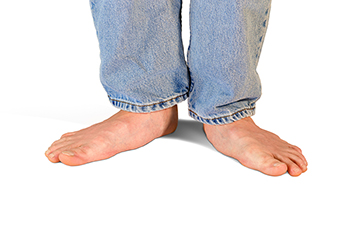 It is not unusual for a child to have a condition known as flexible flat feet. Symptoms include a flattened arch, which results in the feet splaying outward. This may cause some pain in the arch if the child is particularly active. Avoiding weight-bearing activities, such as running, and turning instead to cycling or swimming, can give the heels a rest. Stretching the outer calf muscles on a daily basis can also help. Wearing shoes with cushioning and support as well as a slight heel can help to decrease pounding on the heel and the flattening of the arch. Custom orthotics can also be used to help eliminate discomfort. A podiatrist can perform tests to determine the severity of the case and suggest several remedies to reduce the symptoms. It is a good idea to plan regular visits to allow the doctor to monitor your child’s foot condition on a regular basis.
It is not unusual for a child to have a condition known as flexible flat feet. Symptoms include a flattened arch, which results in the feet splaying outward. This may cause some pain in the arch if the child is particularly active. Avoiding weight-bearing activities, such as running, and turning instead to cycling or swimming, can give the heels a rest. Stretching the outer calf muscles on a daily basis can also help. Wearing shoes with cushioning and support as well as a slight heel can help to decrease pounding on the heel and the flattening of the arch. Custom orthotics can also be used to help eliminate discomfort. A podiatrist can perform tests to determine the severity of the case and suggest several remedies to reduce the symptoms. It is a good idea to plan regular visits to allow the doctor to monitor your child’s foot condition on a regular basis.
Flatfoot is a condition many people suffer from. If you have flat feet, contact Dr. Randy Garr from Bigfoot Podiatry. Our doctor will treat your foot and ankle needs.
What Are Flat Feet?
Flatfoot is a condition in which the arch of the foot is depressed and the sole of the foot is almost completely in contact with the ground. About 20-30% of the population generally has flat feet because their arches never formed during growth.
Conditions & Problems:
Having flat feet makes it difficult to run or walk because of the stress placed on the ankles.
Alignment – The general alignment of your legs can be disrupted, because the ankles move inward which can cause major discomfort.
Knees – If you have complications with your knees, flat feet can be a contributor to arthritis in that area.
Symptoms
- Pain around the heel or arch area
- Trouble standing on the tip toe
- Swelling around the inside of the ankle
- Flat look to one or both feet
- Having your shoes feel uneven when worn
Treatment
If you are experiencing pain and stress on the foot you may weaken the posterior tibial tendon, which runs around the inside of the ankle.
If you have any questions please feel free to contact our office located in Provo, UT . We offer the newest diagnostic and treatment technologies for all your foot and ankle needs.
Flat Feet
Flatfoot is a foot condition in which the arch of the foot has either partially or totally dropped or has never developed. While it is common in babies and small children, it can become a problem for them in adulthood if the arch never forms. For adults, the development of flat feet can be brought upon by injury, as a result of pregnancy due to increased elasticity, or obesity. Those who have health concerns such as rheumatoid arthritis or diabetes may also be at greater risk for developing the condition.
If you suspect that you have flat feet, it is best to consult your podiatrist. Your foot doctor will examine the suspected foot and observe how it looks while you sit and stand. He or she may take an X-ray to determine how serious the condition is. Some common signs of flatfoot include toe drift, in which the toes and front part of the foot point outward, a short Achilles tendon, and a heel that tilts outwardly while the ankle tilts inward.
Once flatfoot has been diagnosed, your podiatrist may suggest one of several treatment options. Flat feet can be rigid, in which the feet appear to have no arch even when the person is not standing; or flexible, in which the person appears to have an arch while not standing, but once standing the arch disappears. Those with flexible flatfoot may be told to reduce any activities that cause pain and to avoid extended periods of walking or standing. Another suggestion may be weight loss, as excessive weight may be placing pressure on the arches
In few cases, if the condition is severe and all other methods have been exhausted surgery may be required. This is normally avoided, however, due to a lengthy recovery time and high cost.
Tips for Preventing Blisters
Foot blisters are a common but very annoying problem. Fortunately, there are many ways to prevent them. First, you should look for a shoe that fits well, holds your heel firmly in place, and leaves some wiggle room for your toes. Avoid buying shoes with rough seams or edges along the inside, as these can irritate the skin. Socks are important too. Look for socks that are made with a moisture-wicking material. These will help keep your feet dry. You can also use an antiperspirant or talcum powder. Toughen the skin on your feet by slowly increasing the distance of your walks or runs and by moisturizing your heels if they are dry. If you have certain areas of your feet that are prone to blistering, cover them with sports tape, moleskin, or special patches to protect them. For more information about how to prevent foot blisters, please consult with a podiatrist.
Blisters are prone to making everyday activities extremely uncomfortable. If your feet are hurting, contact Dr. Randy Garr of Bigfoot Podiatry. Our doctor can provide the care you need to keep you pain-free and on your feet.
Foot Blisters
Foot blisters develop as a result of constantly wearing tight or ill-fitting footwear. This happens due to the constant rubbing from the shoe, which can often lead to pain.
What Are Foot Blisters?
A foot blister is a small fluid-filled pocket that forms on the upper-most layer of the skin. Blisters are filled with clear fluid and can lead to blood drainage or pus if the area becomes infected.
How Do Blisters Form?
Blisters on the feet are often the result of constant friction of skin and material, usually by shoe rubbing. Walking in sandals, boots, or shoes that don’t fit properly for long periods of time can result in a blister. Having consistent foot moisture and humidity can easily lead to blister formation.
Prevention & Treatment
It is important to properly care for the affected area in order to prevent infection and ease the pain. Do not lance the blister and use a Band-Aid to provide pain relief. Also, be sure to keep your feet dry and wear proper fitting shoes. If you see blood or pus in a blister, seek assistance from a podiatrist.
If you have any questions, please feel free to contact our office located in Provo, UT . We offer the newest diagnostic and treatment technologies for all your foot care needs.
Blisters on the Feet
Blisters are a common ailment of people who wear shoes that are either too tight or rub against the feet in an uncomfortable way. Knowing the basics of blisters is important for understanding how they are formed and what treatments should be used for them.
A blister on the foot, or any other part of the body, is a small pocket that is filled with fluid. It usually forms on the upper layer of the skin because these layers are loose enough to allow a blister to form. The most common fluid in a blister is just a clear, watery-like fluid that usually isn’t cause for concern. However, blisters can fill up with blood if they are deep enough and pus if they have become infected with bacteria.
Blisters almost always form on the feet due to shoes rubbing up against the foot, where the friction causes blisters. These can occur after you have walked for a long period of time or when your shoes do not fit you properly. Your feet are also more prone to blisters if they are moist, so keeping them dry and clean is one preventative step you can take.
Preventing infection should be the number one concern when treating blisters, as well as relieving the pain they can cause. Using a bandage to cover up the blister will help it heal and prevent bacteria from entering it. New skin will form under the blister and eventually cause it to pop. You can also take a sterilized pin and try to pop it yourself.
If the blister is filled with pus or blood, seeking treatment from a doctor is ideal. Antibiotics may need to be taken in order to completely eliminate the bacteria inside the blister. See a doctor to have an antibiotic prescribed.
The best way to treat blisters is to prevent them all together. Keeping your feet dry and making sure that your shoes fit properly are just two of the steps you can take to prevent blisters. Shoes that are too tight or shoes that are too loose and allow your feet to slide in them will cause blisters. Applying a bandage to an area where you think a blister is about to form is another way you can prevent them.
Causes and Symptoms of Gout
 When you experience a pain in the joint of your big toe that is accompanied by redness and swelling, you may have a condition known as gout. It is a form of arthritis caused by a buildup of urate in the blood. It ends up producing crystals that form in and around the joints, the most common of which is the joints of the big toe. During a gout flare-up the joint becomes tender, painful, red, hot and swollen. These symptoms can appear overnight, but may take about a week to recede. Gout is more common in older men, especially if they are overweight, eat fat-rich foods, and consume a lot of alcohol. If left untreated, gout can begin to form in other joints. If you think you may be having a flare-up of gout, it is wise to make an appointment with a podiatrist as soon as possible for a proper diagnosis and possible course of treatment.
When you experience a pain in the joint of your big toe that is accompanied by redness and swelling, you may have a condition known as gout. It is a form of arthritis caused by a buildup of urate in the blood. It ends up producing crystals that form in and around the joints, the most common of which is the joints of the big toe. During a gout flare-up the joint becomes tender, painful, red, hot and swollen. These symptoms can appear overnight, but may take about a week to recede. Gout is more common in older men, especially if they are overweight, eat fat-rich foods, and consume a lot of alcohol. If left untreated, gout can begin to form in other joints. If you think you may be having a flare-up of gout, it is wise to make an appointment with a podiatrist as soon as possible for a proper diagnosis and possible course of treatment.
Gout is a painful condition that can be treated. If you are seeking treatment, contact Dr. Randy Garr from Bigfoot Podiatry. Our doctor will treat your foot and ankle needs.
What Is Gout?
Gout is a form of arthritis that is characterized by sudden, severe attacks of pain, redness, and tenderness in the joints. The condition usually affects the joint at the base of the big toe. A gout attack can occur at any random time, such as the middle of the night while you are asleep.
Symptoms
- Intense Joint Pain - Usually around the large joint of your big toe, and it most severe within the first four to twelve hours
- Lingering Discomfort - Joint discomfort may last from a few days to a few weeks
- Inflammation and Redness -Affected joints may become swollen, tender, warm and red
- Limited Range of Motion - May experience a decrease in joint mobility
Risk Factors
- Genetics - If family members have gout, you’re more likely to have it
- Medications - Diuretic medications can raise uric acid levels
- Gender/Age - Gout is more common in men until the age of 60. It is believed that estrogen protects women until that point
- Diet - Eating red meat and shellfish increases your risk
- Alcohol - Having more than two alcoholic drinks per day increases your risk
- Obesity - Obese people are at a higher risk for gout
Prior to visiting your podiatrist to receive treatment for gout, there are a few things you should do beforehand. If you have gout you should write down your symptoms--including when they started and how often you experience them, important medical information you may have, and any questions you may have. Writing down these three things will help your podiatrist in assessing your specific situation so that he or she may provide the best route of treatment for you.
If you have any questions, please feel free to contact our office located in Provo, UT . We offer the newest diagnostic and treatment technologies for all your foot care needs.





